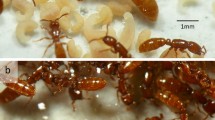Summary.
A review of field and laboratory research concerning raiding behaviour, mating strategies and colony founding in Formica sanguinea and Polyergus rufescens (respectively facultative and obligatory parasites of the Serviformica species) is presented. The analysis and comparison of these crucial and peculiar moments in the life cycle of dulotic colonies may be a valid tool to clarify the evolutionary origins of slavery in ants.¶Concerning the reproductive behaviour, F. sanguinea females mate only in nuptial flights. P. rufescens females mate on the ground around their natal nest, or return to a dulotic colony after mating flights and wait for a raid, or mate directly during a raid. Moreover, field observations suggest that F. sanguinea adopts a strategy similar to the "male aggregation syndrome", whereas P. rufescens mating strategy can be considered similar to the "female calling syndrome". In the field, newly-mated queens of both slave-makers participate in raiding swarms: following a slave raid is an advantageous strategy to locate and invade host nests and to establish a new dulotic colony.¶For colony formation, F. sanguinea presents a great variety of possible strategies (independent foundation and dependent foundation including alliance, adoption, usurpation, and brood sack). This provides evidence of a behavioural plasticity that confirms its nature as a facultative parasite. On the contrary, P. rufescens depends only on usurpation, during which the Dufour's gland contents seem to play a crucial role in the appeasement of the residents of the target colony.¶Also the raiding behaviour of F. sanguinea is less specialized than that shown by P. rufescens. In fact, in the obligatory slave-maker the important role of scouts in the organization of slave-raids is confirmed, which are rapid and effective. By contrast, raids of F. sanguinea may be regarded as a continuation and expansion of common foraging and predatory activity, as predicted by Darwin's hypothesis for the origin and evolution of slavery in ants. Nevertheless, the intraspecific raids conducted by P. rufescens emphasize also the important role of territorial competition as evolutive cause of dulosis.
Similar content being viewed by others
Author information
Authors and Affiliations
Additional information
Received 7 March 2001; revised 6 June 2001; accepted 14 June 2001.
Rights and permissions
About this article
Cite this article
Mori, A., Grasso, D., Visicchio, R. et al. Comparison of reproductive strategies and raiding behaviour in facultative and obligatory slave-making ants: the case of Formica sanguinea and Polyergus rufescens. Insectes soc. 48, 302–314 (2001). https://doi.org/10.1007/PL00001782
Issue Date:
DOI: https://doi.org/10.1007/PL00001782




